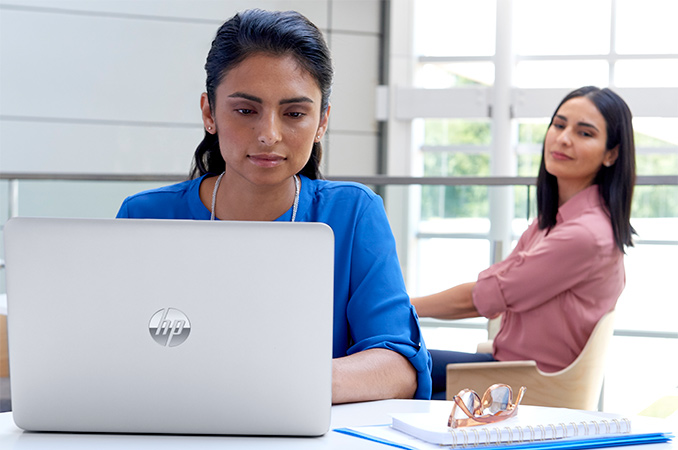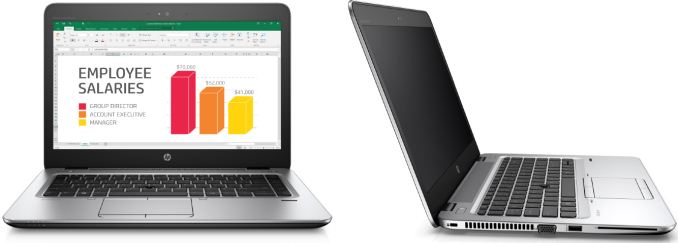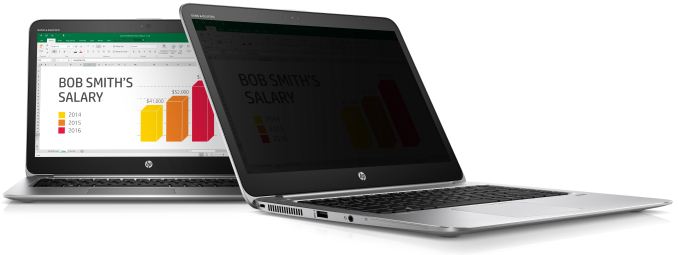HP Announces EliteBook Laptops with On/Off Sure View Privacy Screens
by Anton Shilov on August 26, 2016 10:30 AM EST
On Thursday, HP introduced adjustable privacy screens for the EliteBook 840 as well as the EliteBook 1040 notebooks. These are aimed at business users concerned about visual hacking and disclosing sensitive information to onlookers (something a number of journalists have to consider when working on NDA information when flying back from a press event). The protective measures for the screens are based on the Sure View technology jointly developed by HP and 3M, which relies on a number of HP’s proprietary technologies as well as 3M’s optical films. Ultimately, the user can control the privacy with an on/off switch as required, rather than equipping a perminant film that can reduce comfort. Right now, the Elitebook laptops are the first batch to get the technology, but eventually HP’s Sure View technology may appear on other PCs from the company depending on feedback.
In the conference call, HP was keen to point out that according to the Pew Research Center, around 60% of employees nowadays take their work outside of office walls and can potentially (without knowing) share confidential information with the wrong people. Most users that have to work while on the move might not be aware of who is staring at their displays from the back or from the side (which is incredibly annoying in general even if you are playing Tetris). Knowing that, HP explained that some employees tend not to work with sensitive data in public places, which can reduce their overall productivity. Meanwhile there is a market to ensure privacy in cafes, airports and other venues - other people install aftermarket privacy screens on their laptops. While that helps businesses to better comply with regulatory requirements in healthcare, finance and industries dealing with sensitive information, such screens reduce viewing angles of notebooks which affects overall user experience. By contrast, HP’s Sure View can be turned on and off, thus improving privacy without persistent reduction of viewing angles of laptop screens.
HP’s Sure View technology uses a special film from 3M as well as HP’s own backlighting. When the setting of the backlighting is adjusted, the film decreases viewing angles of the display down to around 35 degrees. The tech can be activated by pressing Fn + F2 and actual viewing angles can be further adjusted by pressing other combinations of buttons (viewing angle adjustments are independent of brightness and one is not dependent on the other). HP claims that the technology can be used with different display panels, but initially the company will use the technology on TN or SVA panels with FHD resolution. The Sure View does not consume extra power and since it relies on different setting of the backlighting, it might help to improve battery life a bit. HP does not reveal the price of its integrated privacy screen technology, but claims that with higher-end configs it will be virtually free. Moreover, the company mentioned that since it is not just a film on top of the display itself, it is going last throughout the lifetime of the laptop.
As for configurations, the HP EliteBook 840 G3 and the HP EliteBook 1040 G3 are 14” laptops based on Intel’s dual-core Core Skylake-U chips with integrated HD Graphics 520 and vPro (select models only). They come with up to 32 GB of DDR4-2133 memory and use 2.5” HDDs/SSDs (EliteBook 840) or M.2 SSDs (EliteBook 1040). The notebooks are equipped with 802.11ac WiFi + Bluetooth modules, Gigabit Ethernet (via dongle in case of the 1040) as well as an LTE or HSPA+ WWAN module. As with many business PCs, the systems are equipped with anti-spill keyboards, fingerprint readers (optional in case of the 840) and TPM 1.2/2.0 modules.
Both laptops feature 14” display panels and are fairly light and thin for mainstream business models. The EliteBook 840 weighs 1.48-1.7kilograms and is 1.89-2.02cm thick (the peak values for touch-enabled models. Meanwhile, the EliteBook 1040 weighs starting at 1.43 and is 1.58-1.65cm thick. Depending on the exact configuration, the EliteBook 840 can work for up to 13.5 hours, whereas the EliteBook 1040 can boast with 10 to 11.5 hours of battery life. Since configurations of the notebooks can vary, HP does not mention recommended prices, but we are talking about machines that start at around $1200 and can end up at $2000 or higher. B2B sales will differ in price depending on volume and support packages. Users should see systems with Sure View privacy screens available in September.
Source: HP


















43 Comments
View All Comments
spooh - Friday, August 26, 2016 - link
TN displays are horrible with colors. If you manage to look at the display in the best possible way, colors near the display edges are still distorted. These HP filters could limit viewing angles without distorting colors - that would be very ok in my opinion.JoeyJoJo123 - Friday, August 26, 2016 - link
Here's the joke:See in the top picture, the girl is using her laptop in a public place, but somehow she expects to have any reasonable amount of privacy. The limitation on viewing angles does not prevent someone from looking directly over her shoulder to see what she's viewing, nor does it give real privacy. So in essence, this is a joke solution for a joke problem.
If she _really_ needs that privacy, then she needs to take her laptop with her to a more secluded location, rather than just using it in a public cafe where obviously people are trying look at her screen from behind her.
JoeyJoJo123 - Friday, August 26, 2016 - link
Oh, and even moreso of a joke, chances are the girl's browsing Facebook or using Google services right there in that picture, and ironically enough, these services clearly don't respect your web privacy in any way, whatsoever, so it's even more of a joke that she would care more about what some girl at a cafe can see from over her shoulder, but not care that she's literally handing over personally identifiable information to Facebook/Google.Samus - Friday, August 26, 2016 - link
JoeyJoJo123, the only joke here is you. I don't know if you are clueless, trolling, or a Lenovo employee jelly over HP beating you to the punch on what will likely become an industry-wide feature on corporate laptops. If you've ever been observant of your doctors office (your psychiatrist, perhaps) you'd notice the receptionist likely had a privacy screen.JoeyJoJo123 - Friday, August 26, 2016 - link
I'm not too sure you even understand the concept of what multi-factor authentication means.If something needs to be secure (in other words, private), then it's not as easy as slapping a polarized filter on top of a screen and calling it a day. Likewise, for the same reason, it's not enough to expect any real level of security by slapping on a lock on a bicycle and expect it to not be stolen.
There's a saying, "Locks keep honest people honest." If someone has the intention to look over your shoulder, they will do so and move to a location to where they can view your screen. Likewise, if you leave a $4,000 competition cycling bicycle locked on a bike rack, someone will be buying a $50 bolt cutter and walking away with $3950.
The industry makes billions of dollars a year selling laminate film which serves only to give the user peace of mind that with that $20 filter (manufactured in China by child labor for less than 25 cents, by the way) they won't be hacked. The reason I think these privacy filters are a joke are because:
1) Screen cheating isn't the one and only way to be hacked.
2) It gives a false sense of security/privacy, which is easily circumvented by the perpetrator moving to a location on-axis from the monitor, rather than off-axis.
3) It gives the same effect as just pressing Ctrl + - to make text temporarily smaller, so that users from a distance can't discern the text on the screen.
4) In practice (and I work in an office where privacy filters are just given to new hires, for their company computer(s) and their home computer(s), for free) the majority of users here don't use it for its intended purpose (browsing the internet for personal use, made obvious when the user accidentally pulls their headphones out of the computer, and a loud YouTube video begins to blare out of their speakers in a quiet office, followed by quick shuffling to mute the sound) or remove it because it limits their viewing angle of the screen.
Users at my office know that security comes from the PKI-enabled smart cards that we use to login to computers, to unencrypt encrypted e-mails or documents, or that people who work on sensitive data work in approved environments (read: isolated offices with smart card slots which grant entry only to authorized personnel).
It's not enough to screen cheat, or to carefully look at a user while they're typing in their pin, etc. Everything worth keeping secure here requires multi-factor authentication. That's nothing that a privacy filter solves, and perpetuating this myth that limited viewing angles (although nice that it is optional... on the laptop's integrated monitor only) helps security by any significant margin is a long shot, to say the least.
Hence, privacy filters are a joke.
tarqsharq - Monday, August 29, 2016 - link
Multi-factor authentication is pointless when it just takes someone working next to you to peek over and see what's on your screen.Hospitals, for example, are very crowded in the doctor dictation and nurse station areas. They normally are working right next to other medical professionals who do not have the authorization to see the patient data on the screen next to them. It's just how the business works.
And saying screen cheating isn't the only way to be hacked is an asinine argument against having privacy screens.
Notmyusualid - Saturday, August 27, 2016 - link
+48.10^76Lord of the Bored - Saturday, August 27, 2016 - link
Trufax: The girl in the background is smiling because the facebook post has a hilarious picture.patel21 - Saturday, August 27, 2016 - link
Do you think it would really matter them when working on Word or Excel ??Solandri - Saturday, August 27, 2016 - link
Not all TN displays are created equal. The really bad (cheap) ones suffer from enough color shift that the edges of the display show different colors from the center as you describe. The really good ones are indistinguishable from an IPS-type panel when viewed head-on. My last laptop (Sony VPC-Z) had a TN panel which covered AdobeRGB color space and had a contrast ratio of nearly 2000:1. My current laptop has an IPS panel that "only" has a 800:1 contrast ratio and covers sRGB color space. Every now and then I fire up the Sony to do a little web browsing, and shed a tear. I've even toyed with the idea of buying a new 13.3" laptop and somehow transplanting the Sony screen into it.